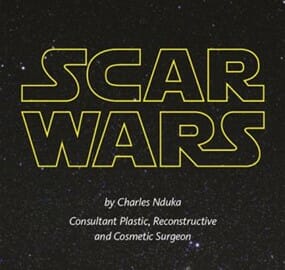By Consultant Plastic, Reconstructive and Cosmetic Surgeon Charles Nduka
Most people have at least one or two scars on their body. Some like to keep them well hidden and others like to show them off, usually as an excuse to recount some intrepid tale, which resulted in them getting their trophy wound.
To many people, a scar is a lasting reminder of a traumatic event and may even cause pain or disability. Unless a scar is with a person from the day they are born then most scars have a background story of some kind. However, not everyone likes to divulge the details of this and they would rather restore their skin to its former smooth self.
Fortunately there are a range of treatments available to help do this as much as possible. Plastic surgeon, Charles Nduka, looks at the range of treatment options appropriate for the main types of scarring:
Normal scars

Ideally a scar should be thin, soft, pale, flat and symptom-free. It can take up to two years for a scar to lay down a stable meshwork of collagen, which is found in fibrous skin tissue, plus other proteins. However, a healed scar will only achieve up to 70% of the strength of normal skin.
Options:
Most plastic surgeons advise their patients to massage a soundly healed wound to encourage a scar to mature. If the scar is pale then applying skin camouflage in the form of cover creams and powders may help. These can be tailored to your skin tone for great results.
Hypertrophic (raised) Scars
These red, raised, itchy scars usually develop 2-3 months after the wound has healed. They are more common in people of Celtic origin or with pigmented skin, and in anyone whose wound takes longer than about 2 weeks to heal.
Options:
Silicone gel has been shown to soften, flatten and smooth hypertrophic scars, and relieve itching, pain and discomfort.
Keloid Scars
These start out looking and feeling very similar to hypertrophic scars, but continue growing beyond the boundary of the original wound. They are more common in people with pigmented skin (Asian, Oriental) and can grow to several centimetres in diameter.
Options:
Injections of steroid by an experienced practitioner into the scar leads to eventual softening and scar flattening, but needs to be repeated every 6 weeks over several months. In resistant cases, surgery can be an option, followed by low dose radiotherapy to minimize the recurrence.
Sunken Scars (aka tethered scars)
Deep incisions that are not carefully closed in layers may result in the scar becoming attached to the deeper structures. These tethered scars are fairly common after emergency operations such as appendix removal and Caesarian section.
Options:
Small scars can be improved by a technique called subcision, where the fibrous bands that cause the scars are broken up by inserting a needle under the skin. The needle is gently moved back and forth, cutting the tethering bands. Larger scars may cause a ‘dragging’ sensation and may require revision.
Stretched Scars
These tend to be flat, but wide and are commonest in areas under a lot of tension such as over joints (knee, elbow, back) and particularly in growing children.
Options:
Prevention is the best form of treatment by supporting scars that are under tension using surgical tape. Wide scars can be revised by a surgeon.Mr Charles Nduka has developed an international reputation in the fields of cosmetic surgery and surgical research. His private practice works to part-fund his research projects in which he investigates the best techniques to improve outcomes in plastic surgery of the face and breast.



